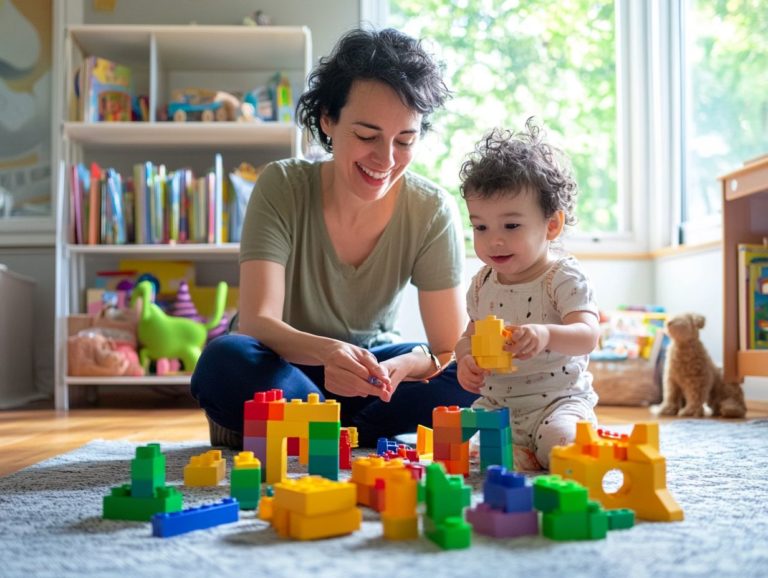5 Best Practices for Mindful Family Communication
Effective communication serves as the cornerstone of strong family relationships. Yet, many families find themselves grappling with the challenge of connecting meaningfully, especially during the busy holiday season.
The encouraging news is that by practicing mindful communication, you can transform your interactions, fostering a deeper sense of understanding and compassion within your family. This article delves into five best practices, including mindful listening and setting weekly routines:
- Active listening
- Speaking with empathy
- Setting boundaries and maintaining stability and wellness
- Practicing forgiveness and engaging in mindful strategies
- Being aware of non-verbal cues and body language
Each section provides you with practical insights designed to enhance family dynamics and build lasting relationships. Discover the power of mindful communication and its potential to enrich your everyday family life, including mindful eating and mindful technology use.
Contents
- Key Takeaways:
- 1. Active Listening and Mindful Listening
- 2. Speaking with Empathy and Mindful Conversations
- 3. Setting Boundaries and Creating Stability
- 4. Practicing Forgiveness and Mindful Strategies
- 5. Being Mindful of Non-Verbal Communication and Body Language
- What Is Mindful Communication, Mindful Listening, and Why Is It Important for Families?
- Why Are Boundaries Important in Family Communication?
- How Can Practicing Forgiveness Improve Family Relationships?
- What Are Some Non-Verbal Cues to Be Mindful of in Family Communication?
- Frequently Asked Questions
- What are the 5 best practices for mindful family communication?
- How can active listening improve family communication?
- Why is setting boundaries important in family communication?
- How can showing empathy enhance family communication?
- What role does forgiveness play in mindful family communication?
- How can practicing these best practices improve overall family dynamics?
Key Takeaways:

- Listen actively to understand, not just to respond. This is an essential practice of mindful listening.
- Speak with empathy by considering others’ perspectives and feelings. This can reduce stress and anxiety within the family.
- Set boundaries to respect each family member’s needs.
1. Active Listening and Mindful Listening
Active listening, also known as mindful listening, is an essential aspect of mindful communication. It significantly enhances your family connections and fosters emotional resilience, particularly during the holiday season when stress levels rise and schedules become busier.
By engaging in active listening, you and your family members can deepen your connections. This creates a serene environment that encourages open dialogue and quality family time together. This practice dramatically reduces conflict and cultivates an atmosphere of understanding and empathy, which is crucial for nurturing healthy relationships.
Incorporating techniques such as repeating back what others say and asking clarifying questions can profoundly improve your interactions with loved ones. For example, if a family member shares feelings of being overwhelmed by holiday preparations, you can actively listen by summarizing their concerns and asking follow-up questions. This makes them feel valued and understood.
This kind of thoughtful engagement minimizes misunderstandings and fosters a sense of unity, making it easier for your family to navigate challenges together and promoting overall wellness and stability. As you embrace these listening skills, you’ll likely notice a decrease in stress, paving the way for more joyful moments and stronger bonds during the bustling holiday season.
2. Speaking with Empathy and Mindful Conversations
Speaking with empathy is essential for fostering understanding and emotional growth within families. It enables you to model mindful practices that promote open communication and strengthen connections among all family members, ultimately leading to improved communication and less conflict.
By actively validating feelings and expressing genuine understanding, you can help create an environment that nurtures deeper relationships. Techniques like repeating back what someone has said to show understanding and acknowledging each other’s experiences pave the way for healthier dialogues. This becomes particularly important during stressful times, such as the holiday season.
Research from experts like MaryJo Burchard underscores that engaging with empathy fortifies family bonds and cultivates emotional resilience a vital skill as families navigate challenges together. Organizations like The Lincoln Center for Family and Youth offer invaluable resources that emphasize these empathetic practices, enabling you and your family to confront difficulties with a united front.
Embracing these practices can lead to a significant reduction in stress and anxiety.
3. Setting Boundaries and Creating Stability
Setting boundaries is a vital practice in family communication that fosters stability and wellness. It ensures that each member’s needs are respected and understood, particularly during the hectic holiday season.
This practice is essential for maintaining a healthy relationship with food, activities, and each other. By establishing clear boundaries, you nurture emotional resilience and reduce stress and anxiety.
This allows your family to interact in a way that honors each individual s feelings and perspectives. When family members openly communicate their limits, it creates a safe space where sensitive topics can be discussed without fear of conflict.
Using ways to care that focus on understanding can be incredibly beneficial in guiding these conversations. For instance, during family gatherings, you might choose to avoid certain topics like finances or past disputes to maintain harmony.
Setting aside specific times for check-ins can ensure that everyone s voice is heard, ultimately fostering healthier dynamics over time. Parents setting an example by respecting these boundaries can further reinforce a culture of mutual respect and stability.
4. Practicing Forgiveness and Mindful Strategies

Practicing forgiveness within your family is a transformative mindful journey that strengthens your relationships. It fosters emotional resilience and reduces stress and anxiety for everyone involved.
This essential approach encourages you and your family members to move beyond past grievances. By embracing forgiveness, you can navigate challenges together, promoting a sense of unity.
This sense of unity becomes especially crucial during emotionally charged times, such as the holiday season. Mindful strategies, like a digital detox or setting daily intentions, can enhance this practice.
Implementing practical strategies, like mindful breathing exercises, can create a calming atmosphere that encourages open communication. This allows you to express your feelings authentically.
Engaging in honest conversations about grievances fosters a deeper connection, paving the way for resolution and emotional healing. Such practices can transform potentially stressful gatherings into opportunities for joy and bonding.
5. Being Mindful of Non-Verbal Communication and Body Language
Being mindful of non-verbal communication is crucial for enhancing emotional development and understanding within your family. After all, body language often speaks volumes, especially in emotionally charged situations.
In such scenarios, mindful conversations can be particularly effective. To foster deeper connections, pay close attention to subtle cues like eye contact, posture, and facial expressions during conversations.
For example, if you notice your child crossing their arms while discussing something, it could be a sign of discomfort or defensiveness. By tuning into these signals, you can adjust your approach softening your tone or encouraging a more open dialogue.
Implementing mindfulness routines, such as family check-ins where each member shares their thoughts while the others listen actively, can create an atmosphere of respect and awareness.
Techniques like practicing active listening, maintaining an open posture, and mirroring positive expressions can lead to more enriching interactions. Engaging in activities that promote internal awareness can considerably enhance family dynamics.
What Is Mindful Communication, Mindful Listening, and Why Is It Important for Families?
Mindful communication is a powerful approach that encourages you to actively pay attention and deepen your connections with family members. It fosters emotional strength through open dialogue and awareness of each other’s needs. In today’s fast-paced world, overflowing with professional obligations and technological distractions, this practice becomes essential. It involves mindful listening, mindful eating, and mindful technology use.
Engaging in mindful communication means being fully present and attentive. It involves listening without judgment and responding thoughtfully rather than reactively. By weaving mindfulness into family interactions, you can navigate stressful situations with greater ease. This creates a supportive environment where every voice is heard and valued. This approach promotes quality family time and overall well-being.
Organizations like Concord Solutions highlight the importance of trauma-informed care (an approach that recognizes the impact of trauma on individuals). They urge families to adopt strategies that foster patience and understanding. By cultivating an atmosphere where family members feel safe to express their feelings and concerns, you can build trust, reduce anxiety, and enhance emotional well-being. Techniques such as mindful breathing exercises can further support these goals.
How Can Active Listening and Mindful Listening Improve Family Communication?
Active listening, or mindful listening, can elevate family communication by creating an atmosphere of understanding and emotional resilience. This approach enables each family member to connect on a deeper level and navigate the complexities of their relationships.
Incorporating active listening techniques such as maintaining eye contact, nodding, and summarizing what others say can cultivate a supportive environment. Everyone feels heard and valued, especially during challenging times like holiday gatherings or everyday pressures. These techniques pave the way for open discussions and minimize misunderstandings.
By placing a premium on active engagement, you strengthen family connections and foster emotional resilience. This creates a safe space for expressing feelings and thoughts, enabling relationships and equipping family members to address conflicts with heightened empathy and compassion.
What Are Some Ways to Speak with Empathy and Engage in Mindful Conversations in Family Conversations?

In family conversations, you can easily cultivate empathy through a variety of mindful practices. By acknowledging feelings, validating experiences, and using compassionate language, you enhance the emotional development of everyone in the family. Engaging in mindful conversations is key to this process.
For example, when your child expresses sadness about a friend moving away, take a moment to listen actively. Maintain an open and warm tone, and say, “I can see how much this hurts you.” This acknowledgment validates their feelings and strengthens the bond of trust within your family. When communication becomes challenging during busy times, it’s crucial to engage fully.
Using phrases that highlight shared experiences, such as, “We’ve all felt the sting of losing someone,” fosters deeper connections among family members. These empathetic approaches enhance individual resilience and promote healthier, more constructive interactions within your family unit. Creating an environment for mindfulness deepens your connections with each other.
Why Are Boundaries Important in Family Communication?
Establishing boundaries is essential for fostering healthy family communication. They create a space of respect and understanding, which are key ingredients for nurturing strong family ties and ensuring the well-being of each member.
When parents set an example in respecting boundaries, they can significantly influence family dynamics.
By recognizing the various types of boundaries emotional, physical, and time you can enhance interactions within your family. Emotional boundaries enable you to share your feelings without the fear of judgment, creating a supportive environment where everyone feels appreciated.
Physical boundaries clarify the personal space each family member needs, which is especially crucial during close-knit gatherings. Time boundaries determine when family members can be present for one another, enabling quality interactions without the risk of overlap or burnout. This structured approach leads to reduced stress and anxiety within the family.
Setting these boundaries alleviates stress, particularly during the bustling holiday season. They pave the way for more meaningful moments together and enrich overall family harmony. Increased awareness of each other’s needs can further contribute to this harmony.
How Can Practicing Forgiveness Improve Family Relationships?
Concord Solutions, a mental health advocacy group, suggests that regularly practicing forgiveness can improve family relationships by reducing tension and encouraging mindful interactions.
Practicing forgiveness is a profound act that enhances family relationships by fostering emotional resilience and nurturing a culture of understanding and mindfulness. This contributes to a more mindful environment conducive to emotional growth.
In a world where conflicts are not just possible but inevitable especially among family members embracing forgiveness creates a nurturing environment where feelings can be freely expressed and addressed.
This transformative journey enables families to break free from the constraints of resentment and anger, paving the way for deeper connections and emotional healing. Setting a daily intention to practice forgiveness can be a powerful tool in this journey.
By actively engaging in forgiveness, you can cultivate compassion, enhance communication skills, and build a robust support system that can withstand life’s challenges.
To practice forgiveness together, try these methods:
- Hold regular discussions about your feelings.
- Designate a ‘feelings night’ to air grievances constructively.
- Establish rituals that celebrate reconciliation.
Such practices strengthen your relationships and create a safe space for vulnerability and growth. Creating a calm environment during these discussions can further aid emotional healing.
What Are Some Non-Verbal Cues to Be Mindful of in Family Communication?
MaryJo Burchard of The Lincoln Center for Family and Youth highlights the importance of understanding non-verbal cues in family communication, especially in diverse family dynamics.
Being mindful of non-verbal cues, like body language and facial expressions, is vital in family communication. These signals often carry profound emotional insights that can either strengthen bonds or lead to misunderstandings. Family engagement in activities where these cues are discussed can foster better understanding.
Recognizing that crossed arms might indicate defensiveness or that a smile can signal warmth is crucial for nurturing family relationships. It’s essential for you and your family members to cultivate an awareness of these subtle signals to create a supportive environment that encourages emotional growth. Engaging in shared activities can provide practical settings to understand these non-verbal cues.
To enhance this awareness, consider engaging in regular discussions about feelings and experiences, ensuring that everyone feels at ease expressing themselves. Practicing active listening where you focus entirely on the speaker’s verbal and non-verbal messages can significantly improve understanding and connection within your family unit.
Paying attention to these cues can help in connecting with family members on a deeper level.
In conclusion, establishing boundaries, practicing forgiveness, and being mindful of non-verbal cues are essential steps in improving family communication and relationships. By implementing these strategies, families can foster a supportive and nurturing environment that encourages emotional growth and connection.
Frequently Asked Questions

What are the 5 best practices for mindful family communication?
- Active listening
- Open and honest communication
- Setting boundaries
- Showing empathy
- Practicing forgiveness
How can active listening improve family communication?
Active listening involves paying full attention to what the other person is saying without interrupting or judging. This creates a safe and supportive environment for open and honest discussions.
Why is setting boundaries important in family communication?
Setting boundaries helps establish healthy and respectful relationships. It allows each family member to express their needs and expectations, promoting mutual understanding and respect in many families today.
How can showing empathy enhance family communication?
Showing empathy means understanding and acknowledging the feelings and perspectives of others. This promotes understanding, reduces conflicts, and strengthens relationships.
What role does forgiveness play in mindful family communication?
Forgiveness allows family members to let go of past conflicts, fostering healthier and more positive relationships. It encourages open communication and can be supported by involving mental health professionals.
How can practicing these best practices improve overall family dynamics?
Incorporating these practices leads to improved family dynamics. It strengthens relationships and creates a more harmonious family environment. Collaborating with organizations such as The Lincoln Center for Family and Youth or Concord Solutions can provide additional resources for support.
Imagine a family where everyone feels heard and understood. Start transforming your family’s communication today!






